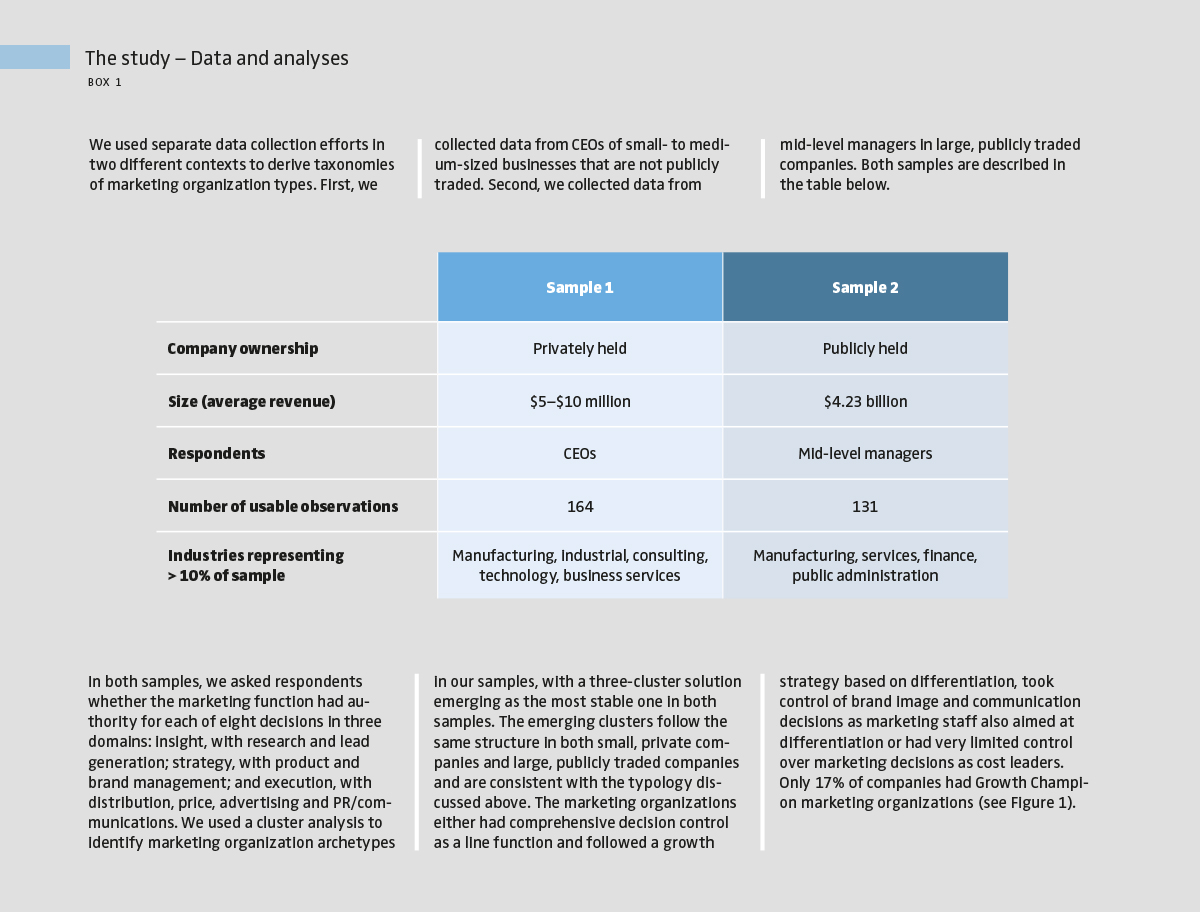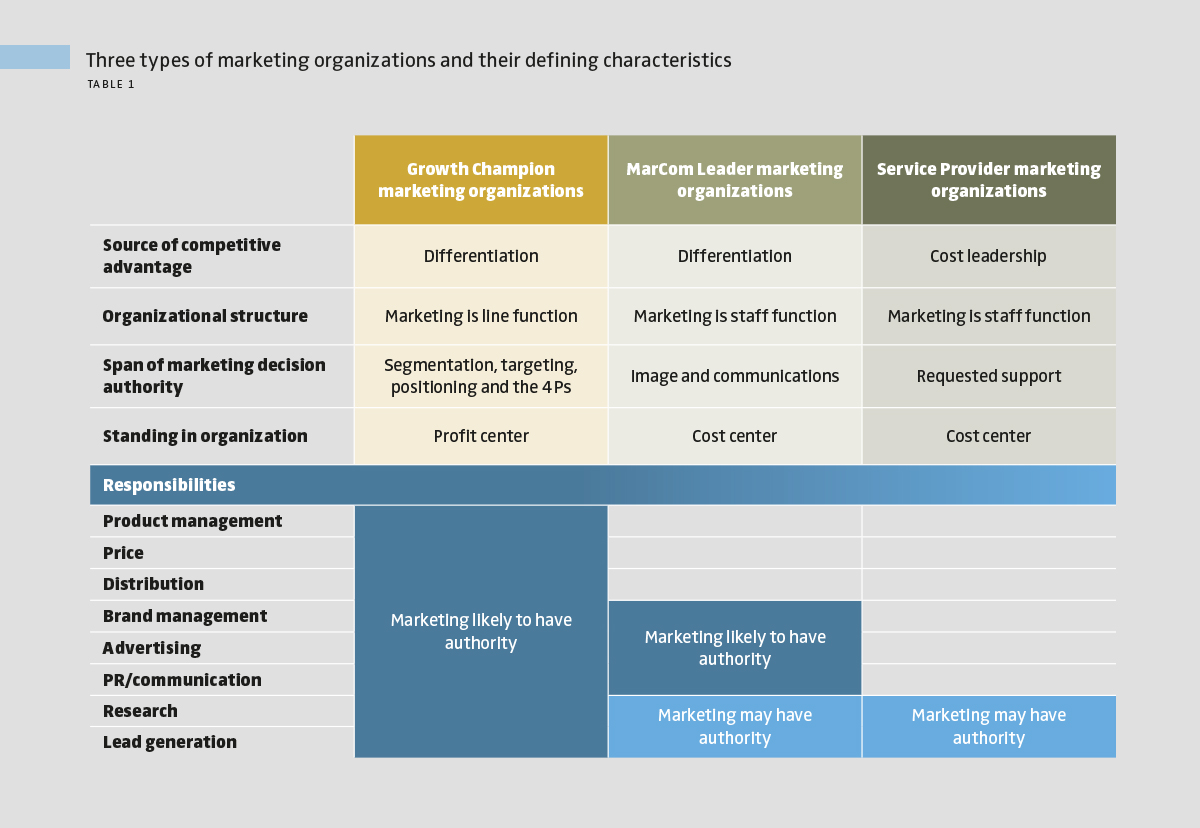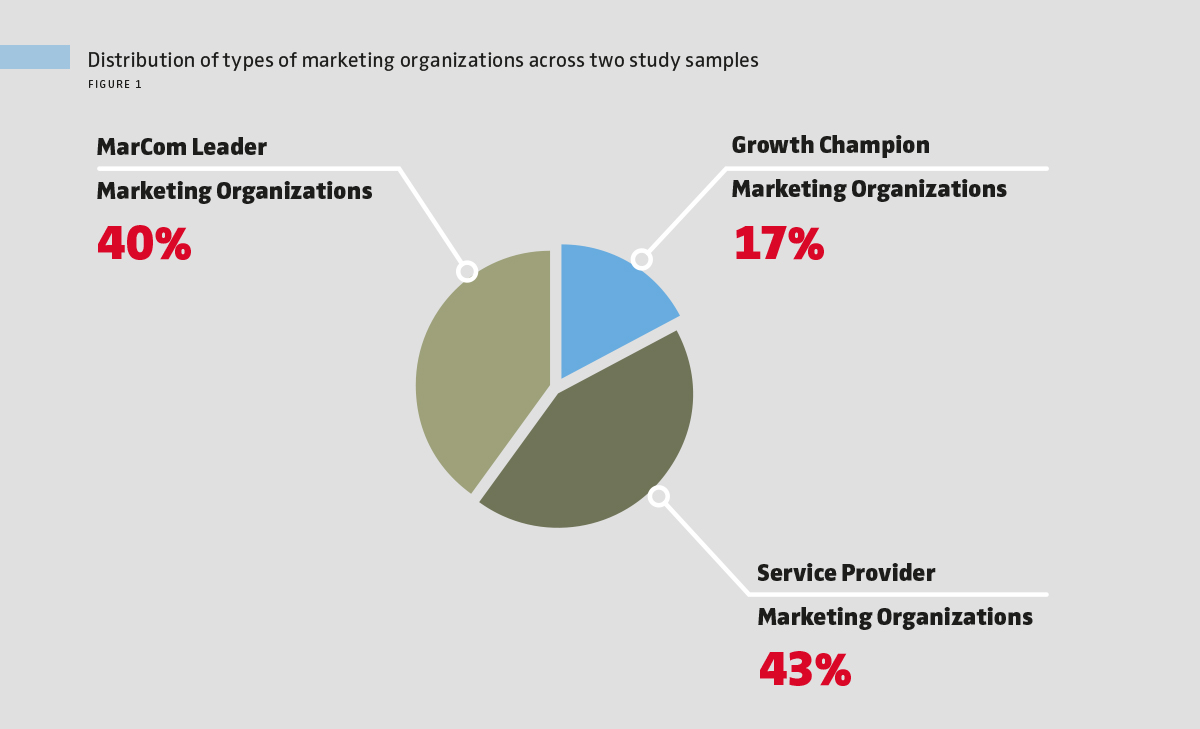Aspirations in Marketing? Pick the Right Company!
Marketing textbooks implicitly suggest that in every company, marketing plays a key role for making customers happy, building high-value brands and achieving sustained growth. They imply the existence of a single marketing organization type that controls all marketing decisions such as segmentation, targeting, positioning, as well as the 4Ps of product, place, price and promotion. This view of marketing as all-encompassing gets reinforced by high-profile companies such as Johnson & Johnson, Procter & Gamble and Unilever, which visit university campuses to deliver guest lectures or recruit top students for marketing positions. Naturally, then, marketing students enter the job market with the expectation that marketing jobs will grant them decision-making power and upward mobility. But are these expectations realistic? What´s the role and scope of marketing in real-world businesses? Is marketing a C-level job?
The marketing function differs depending on the source of competitive advantage
In reality, the range of decisions over which marketing has control can be very diverse. One aspect that might explain differences in marketing power is a company’s source of competitive advantage. While differentiation requires businesses to focus externally to identify customer needs that they can serve distinctively well, cost leadership requires an internal focus to identify opportunities for cost reduction. In the first case, the top management team tends to focus on output like sales and profit, and marketing is designed to address this focus. In the second case, the top management team tends to focus on throughput like economies of scale and scope, to which marketing has little to contribute.
Marketing as line or staff function
Organizations adopt structures to simplify decision-making and ensure the clear delineation of responsibility for market performance. Functions that directly advance an organization in its core work by making business-critical decisions are typically designed as “line” functions. Line managers must bring a decision to closure and commit the organization to action, and they are held accountable for the outcome. They have profit and loss responsibility. In addition to line functions, businesses need staff functions. People who perform staff functions make recommendations to, provide input for, or sign off on line manager’s decisions. For example, staff might be responsible for making proposals or offering alternatives. Staff might alert the line manager to potential problems that a particular decision could create for other parts of the organization. In sum, line functions have direct responsibility for accomplishing the primary objectives of the enterprise, while staff functions help line functions work more effectively in accomplishing those primary objectives. In many organizations, production and sales are line functions; human resources, accounting and legal are staff functions. Interestingly, marketing is a line function in some companies but a staff function in others. When marketing is a line function, it is likely to have authority over most or all decisions related to situation analysis, strategy and the 4Ps. However, when marketing is a staff function, it does not control business-critical decisions. Instead, marketing is likely to be responsible for brand image and communications. Marketing probably provides input on decisions related to price, revenue and profit, but the control of these decisions rests with the line function.
Three types of marketing organizations
Given the aforementioned sources of competitive advantage and organizational structure, we expected to find three distinct types of marketing organizations. Supporting this expectation, an empirical study – comprising two analyses conducted in markedly different settings (see Box 1) – revealed three marketing organization archetypes: Growth Champions, where marketing is a profit center that leads company growth; MarCom Leaders, where marketing is a cost center that manages brand image; and Service Providers, where marketing is a cost center that fulfills requests for support from other functions. The first two types are found in companies that derive competitive advantage from differentiation, while the third is found in companies that derive competitive advantage from cost leadership. In the first type, marketing is a line function; in the second and third, it is a staff function (see Table 1).
> Growth Champion Marketing Organizations
This is the marketing organization type that one would expect to see in a differentiating company in which marketing is a line function. It resembles the typical textbook vision of marketing: being powerful and having authority over decisions critical to the success of the business. In this form, marketing is likely to have full responsibility for brand management, including advertising, promotion and PR/communications decisions, as well as product management, including product, price and distribution decisions.
> MarCom Leader Marketing Organizations
This is the marketing organization type that one would expect to see in a differentiating company in which marketing is a staff function. This form of marketing organization typically has authority for brand management, including advertising, promotion and PR/communications decisions. These marketing organizations are not likely to have authority for product management.
> Service Provider Marketing Organizations
This is the marketing organization type that one would expect to see in a cost leader company. Its main role is to support line functions, who have decision-making authority over core tasks. Like “creatives” in an ad agency, these service providers act more as facilitators than strategic decision makers. They might conduct market studies, develop brochures for the salesforce or generate leads, but they are unlikely to have authority over brand or product management.
Most real-world companies have marketing departments with limited decision authority
In our sample, marketing was not a line function in approximately 83% of cases. Instead, it primarily focused on image and brand communication or served as a support unit for other functions. Notably, for businesses to grow, their product and brand strategies must be designed to address a specific customer problem. To ensure the success of these strategies, all external communications must consistently articulate how the company solves that problem. In 83% of the organizations we examined, individuals outside the marketing function were responsible for gathering insights, setting strategy and creating communications. Regardless of their functional backgrounds, these decision makers must work in a tightly coordinated manner to achieve strategic alignment.
Marketing is not all the same
Both in marketing education and when searching for a job, the different forms of marketing organization should be considered.
> Marketing educators: Acknowledge that marketing jobs in different companies offer different levels of opportunity.
Marketing textbooks explain the range of decisions that influence a company’s growth path. However, they fail to clarify that those growth-related decisions are not necessarily made by employees with marketing titles. Marketing educators should point out in their courses and textbooks that not every company has an “all powerful” marketing organization. We do our students a disservice if we recruit them into our marketing majors by promising that, as marketers, they will have profit and loss authority in every company. The presented taxonomy provides a framework for presenting the different types of marketing organizations that exist. Equipped with this insight, marketing students wil be in a better position to assess their options and pursue marketing jobs that best fit their career goals.
> Marketing talent: Go for line jobs in growth leader companies!
Talented people interested in marketing positions need to know what role the marketing function plays in companies they are considering. If marketing is the growth driver, then marketing jobs are likely to be challenging, well-compensated and “fast track” to top management. If marketing is merely a support organization, then the jobs are likely to be less challenging and lower compensated and offer a limited future. No matter what career marketers are interested in, they need to know whether the job being offered is in a line function or a staff function. If marketers want high compensation, challenge and a shot at the top, they should join the line function in the company in which they take a job.
FURTHER READINGS
McAlister, L., Germann, F., Chisam, N., Hayes, P., Lynch, A., & Stewart, B. (2023). A taxonomy of marketing organizations. Journal of the Academy of Marketing Science, 51(3), 617-635.
doi.org/10.1007/s11747-022-00911-5













